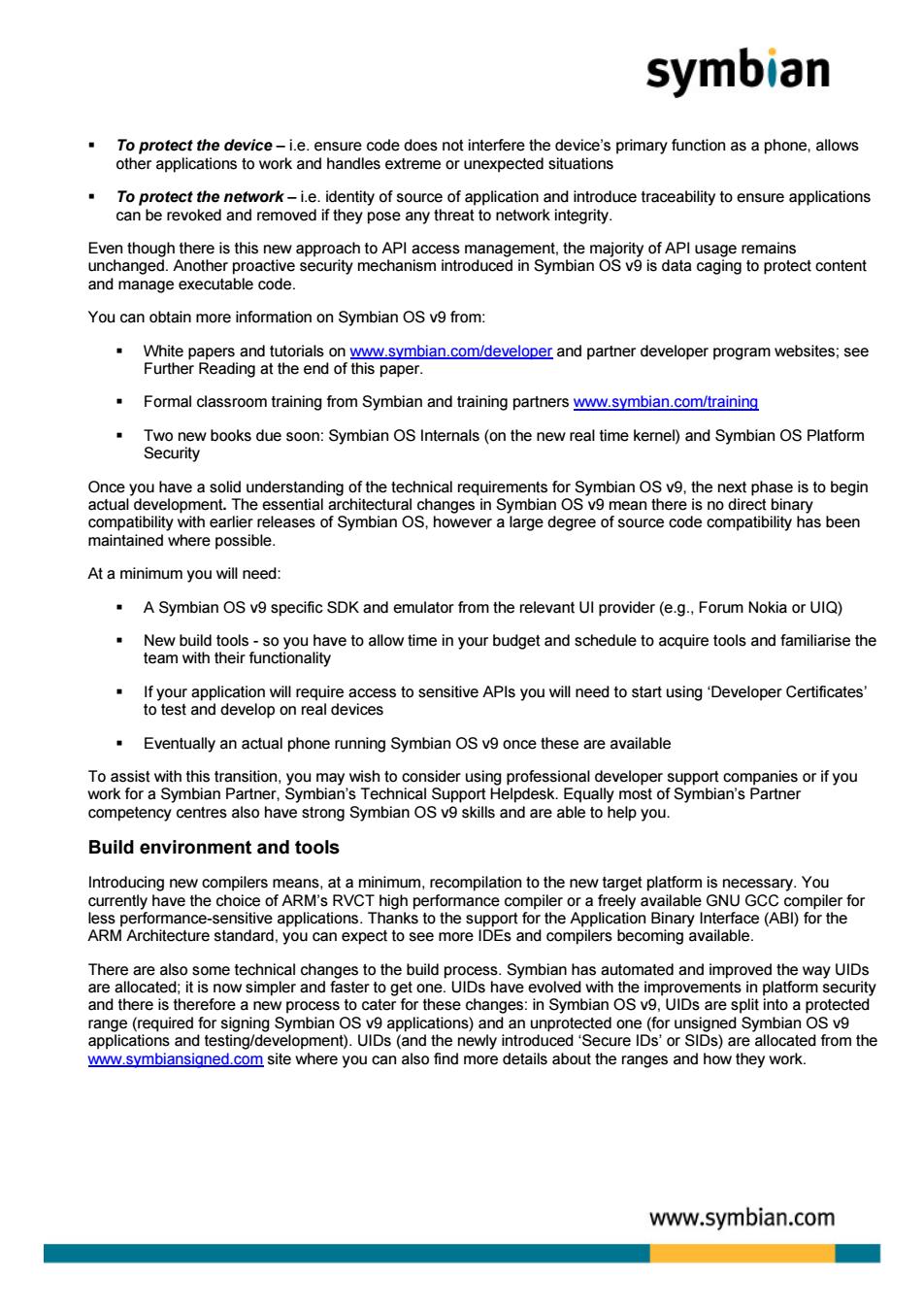正在加载图片...

symbian .Toprotect the device-i.e.ensure code does not interfere the device's primary function as a phone,allows other applications to work and handles extreme or unexpected situations e of an uce traceability to ensure applications unchanged.Anot and manage exec bbeoe You can obtain more information on Symbian OS v9 from Formal classroom training from Symbian and training partners www.symbian.com/training Two new books due soon:Symbian OS Internals(on the new real time kemel)and Symbian OS Platform Security compatibility with earlier releases of Symbian S.however a large degree of source code compatibility has been maintained where possible At a minimum you will need ASymbian OS v9 specific SDK and emulator from the relevant Ul provider (e.g.Forum Nokia or UIQ) ave to allow time in your budget and schedule to acquire tools and familiarise the ss to sensitive APIs you will need to start using'Developer Certificates Eventually an actual phone running Symbian OS v9 once these are available competency centres also have strong Symbian OS v9 skills and are able to help you. Build environment and tools currently have the choice of ARM's RVCT higl ecompiler or a freely available GNU GCC com standard.you canex There are als Symbian has mated and improved the way ulds tertogetrone in c range(required for signi na sy 9appcatonsyandamunproletegoneorunsignedsy oS v9 ed from the ere you details about the ange www.symbian.com To protect the device – i.e. ensure code does not interfere the device’s primary function as a phone, allows other applications to work and handles extreme or unexpected situations To protect the network – i.e. identity of source of application and introduce traceability to ensure applications can be revoked and removed if they pose any threat to network integrity. Even though there is this new approach to API access management, the majority of API usage remains unchanged. Another proactive security mechanism introduced in Symbian OS v9 is data caging to protect content and manage executable code. You can obtain more information on Symbian OS v9 from: White papers and tutorials on www.symbian.com/developer and partner developer program websites; see Further Reading at the end of this paper. Formal classroom training from Symbian and training partners www.symbian.com/training Two new books due soon: Symbian OS Internals (on the new real time kernel) and Symbian OS Platform Security Once you have a solid understanding of the technical requirements for Symbian OS v9, the next phase is to begin actual development. The essential architectural changes in Symbian OS v9 mean there is no direct binary compatibility with earlier releases of Symbian OS, however a large degree of source code compatibility has been maintained where possible. At a minimum you will need: A Symbian OS v9 specific SDK and emulator from the relevant UI provider (e.g., Forum Nokia or UIQ) New build tools - so you have to allow time in your budget and schedule to acquire tools and familiarise the team with their functionality If your application will require access to sensitive APIs you will need to start using ‘Developer Certificates’ to test and develop on real devices Eventually an actual phone running Symbian OS v9 once these are available To assist with this transition, you may wish to consider using professional developer support companies or if you work for a Symbian Partner, Symbian’s Technical Support Helpdesk. Equally most of Symbian’s Partner competency centres also have strong Symbian OS v9 skills and are able to help you. Build environment and tools Introducing new compilers means, at a minimum, recompilation to the new target platform is necessary. You currently have the choice of ARM’s RVCT high performance compiler or a freely available GNU GCC compiler for less performance-sensitive applications. Thanks to the support for the Application Binary Interface (ABI) for the ARM Architecture standard, you can expect to see more IDEs and compilers becoming available. There are also some technical changes to the build process. Symbian has automated and improved the way UIDs are allocated; it is now simpler and faster to get one. UIDs have evolved with the improvements in platform security and there is therefore a new process to cater for these changes: in Symbian OS v9, UIDs are split into a protected range (required for signing Symbian OS v9 applications) and an unprotected one (for unsigned Symbian OS v9 applications and testing/development). UIDs (and the newly introduced ‘Secure IDs’ or SIDs) are allocated from the www.symbiansigned.com site where you can also find more details about the ranges and how they work